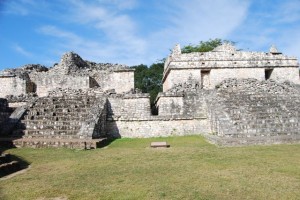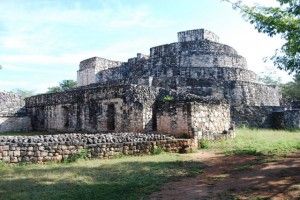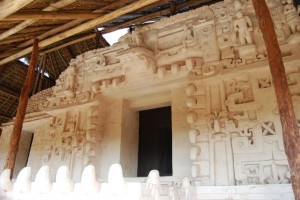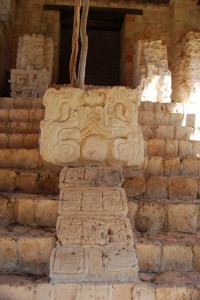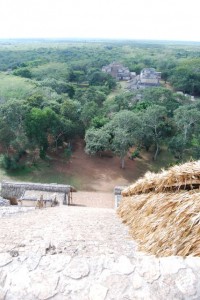The Ruins at Ek’ Balam Posted by sasha on May 12, 2012 in Uncategorized
After a day of wandering around the cobblestone streets of Valladolid, enjoying the architecture and the crystal clear water of the cenote, we headed out on a day-trip to explore the ruins of Ek’ Balam, another ancient Mayan city. As the ruins are a good 30 km away from the city, we took a collectivo to get out there – a shared taxi that locals used to get from the city center out to their homes in the countryside. Mayan for “Black Jaguar,” Ek’ Balam was once a thriving and influential city, having been founded sometime in the middle of the Pre-Classic period (100 BC to 300 AD). Although it was rediscovered by archaeologists in the 1800s, it took nearly a century for excavations to begin. Today, the ruins are open to visitors, with both Spanish and English speaking guides available for hire.
Arriving at the site rather early, it was clear that Ek’ Balam is not nearly as popular with tour groups as the nearby ruins of Chichen Itza, where we had just been a few days prior. If you want some more peace and quiet in your explorations of Mayan ruins, Ek’ Balam is definitely the place to go, and works great sandwiched in between the more popular and thus busier spots like Chichen Itza and Tulum. We strolled down the path to the entrance, which is connected to a sacbe, an ancient road that probably connected Ek’ Balam to other Mayan kingdoms. The city is also surrounded by the remnants of a city wall, which was used for protection and to show military strength.
Restoration at the site has been ongoing since 1997, and only the center of the city has been full excavated. With little ground to cover, a trip out to Ek’ Balam proved to be quite leisurely and enjoyable. After passing through the entrance, we came to the two identical structures known as “The Twins,” which feature mirroring temples on either side. We climbed to the top of the Oval Palace, which contained burial relics and was most likely used in special ceremonies. From atop the temple, we took in the view of the surrounding jungle, which stretched out in every direction.
Relatively little is known about the history of this city, but archaeologists are quite excited about what they’ve been finding in their work there. Even without detailed information about the structures, the stunning architecture and art on display here are enough, and it left us in awe of what the Mayans were able to accomplish in their time. We saw what appeared to be a few other temples, as well as another Mayan ball court.
For a prime example of the Mayan’s achievements, one need look no further than the elaborate Acropolis pyramid at Ek’ Balam, also known as El Trono (The Throne). This massive structure (it measures 480 feet across, 180 feet wide and 96 feet tall) is clearly the work of many generations, with structure built upon structure. Around the outermost layer archaeologists discovered a tomb, with an entrance shaped like a jaguar’s mouth. This represents a portal to the underworld, and its intimidating fangs certainly give you that feeling. It is thought that the Acropolis was the tomb of a Mayan King, called Ukit Kan Le’k Tok’, who ruled during the height of the city.
Perhaps the most impressive aspect of this temple are the incredibly intricate stucco designs that have been preserved. Featuring carvings of angels, animals, and other figures, these represent the Mayans attention to detail and their superior artistic skills.
Unlike at Chichen Itza, visitors at Ek’ Balam are free to climb to the top of the main temple. Once we reached the summit, all other guests in the park had vanished – it was just us and the Mexican workers taking a siesta in their lawn chairs. Having traveled from the insanely busy, crowded, and noisy streets of Beijing, we thoroughly enjoyed a few minutes of solitude, staring out at the vast jungle and breathing in the raw energy of this historical Mayan city. For as far as the eye could see, there was nothing but tree tops and open sky. Looking down on the once thriving city that had been buried for hundreds of year was a reminder about the fleeting nature of life and how easily everything can change. Unfortunately, all good things must come to an end, and we had to power on with our trip, as we headed back to Valladolid to collect our belongings and hop the bus to the final stop on our Mayan tour at Tulum.
*NOTE: This is a re-post since we updated the format of the blog.

Build vocabulary, practice pronunciation, and more with Transparent Language Online. Available anytime, anywhere, on any device.




